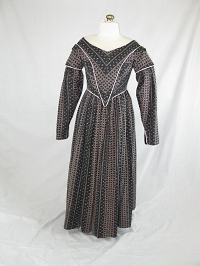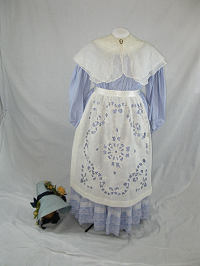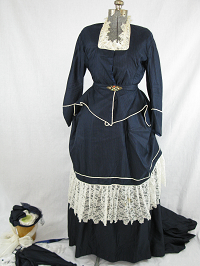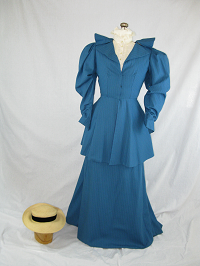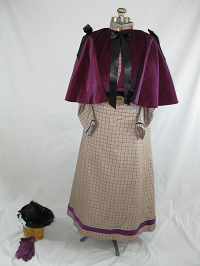
- Details
- Category: 19th century
- Hits: 2966
1840
By the 1840s, America was sending cotton all over the world. Systems of transportation were growing at a fantastic rate. Immigrants were arriving by the tens of thousands. Fashions of the 1840s changed to darker tones and cottons were in use, especially for everyday wear. In Philadelphia and New York, women visited the new department stores to purchase parasols with tilting shafts, upside down walking sticks, long net gloves, cloth boots, lace by the yard, soul comforters (chemisettes) and bonnets. The large brimmed bonnet of the 1830s have started to lose their popularity and will soon become small confections that just sat on the back of the head. The low neckline increased the use of kerchiefs, collars, and capelets. A small sheer pelerine is used to protect Peggy from a chill. In winter they were made of wool or fur. A woman would carry a muff to match.
This day dress is of floral printed cotton. The full skirt is unlined for everyday wear and is faced with a stiff material to help hold out the gown. Shirring, tucks, and piping were used to give a diagonal line to the bodices. The drop shoulder and low neckline also contribute to the wide shoulder illusion. Light blue piping emphasizes the pointed waist and seam detail. Sleeves are still cut very full at the top but closely ruched and hidden under the small over sleeve. Back fastenings continued to be used until the end of the 1840s. Ladies wore the mitts and gloves in the house even while doing embroidery. Petticoats ranged from 4 to 6 according to the seasons. Only the outermost was decorative. Stiff knee length horsehair skirts were worn below the growing number of petticoats to help support the dress. The wearing of bloomers had filtered down through the middle to the lower classes by this time although they were still rather plain. The chemise, with long or short sleeves, became the second layer of clothing with the introduction of a new undergarment, a woolen vest, worn next to the skin. The indoor cap of lawn and lace worn in different forms for many years is also fading as a fashion.
Click photo for detailed views.
- Details
- Category: 19th century
- Hits: 2547
1840s
By the 1840s upper and middle class women's existence was becoming more sedentary, they took little outdoor exercise, and in the home gentility forbade active domestic work. Leading the life of a caged canary they were in delicate health. Gowns were worn over heavy underclothes which were made in private by hand. Making these was considered a suitable occupation and they became experts with a needle.
This gown is of blue cotton with lace and a flounce. The unshaped skirt brushes the floor to expose a tiny toe. The waistline has returned to its normal position. The large brimmed bonnet, trimmed with ribbon and flowers, protects from the sun, as does her pelerine (a cape with pointed ends at the center front). The natural waistline has returned and skirts grew to make this waistline look smaller. They were cut of several widths of material unshaped and gauged on to the bodice. To obtain the 5-foot-wide necessary, petticoats became numerous. On Sunday afternoons, maids would go walking with feather dusters stuffed beneath their skirts to obtain the fashionable dimensions. Petticoats ranged from 4 to 6, according to the season. Only the outermost was decorative. Stiff knee length horse hair skirts were worn below the growing number of petticoats to help support the dress.
The little girl style of the 1830s grew into the subdued woman. She put away her bounce, curls, and fluttering ribbons and became more serious and confined. The bonnet closed in around her face and the hem line droops to the floor. Nothing is seen except a tiny toe. Parasols and pelerines sheltered this demure woman of the 1840s. Style called for the low neckline, even for children, but for the modest Victorian woman, it was only exposed for formal occasions such as dinners and balls. Tuckers and pelerines were used to cover the shoulders during the day. A fancy apron of cut work shows off milady's handiwork. Caps of sheer cotton and yards of lace covered the head. Lace frames the face and can be seen when worn under the bonnet. Little jewelry was worn despite the low necklines. Antique gowns of this and later periods have watch pockets sewn into the waist bands. Beginning in the 1840s watches had moved from a chain worn around the neck into a pocket. Although the leg-of-mutton sleeves have collapsed the interest is still at the top of the arm with rows of gathers. Dry goods stores now stocked ready-made garments which required no fitting, such as chemises, petticoats, capes and mantles. Sewed muslin dresses mentioned in newspaper ads were only partly completed. Finished skirts were purchased, with a length of cloth to make the bodice.
Little jewelry was worn despite the low necklines. Antique gowns of this and later periods have watch pockets sewn into the waist bands. Beginning in the 1840s watches had moved from a chain worn around the neck into a pocket. Although the leg-of-mutton sleeves have collapsed the interest is still at the top of the arm with rows of gathers. Dry goods stores now stocked ready-made garments which required no fitting, such as chemises, petticoats, capes and mantles. Sewed muslin dresses mentioned in newspaper ads were only partly completed. Finished skirts were purchased, with a length of cloth to make the bodice.
Click photo for detailed views.
- Details
- Category: 19th century
- Hits: 2698
1873
The 1870s saw an even greater expansion of the country and American life. Philadelphia staged an exposition to celebrate the Centennial. There they served the first ice cream soda. In women's fashion, extravagance continued. The sewing machine allowed masses of trimming to be applied cheaply. An industrious laborer was as well clad as any millionaire. Fashions did not disappear all of a sudden, but faded gradually through modifications.
In the 1870s, a well-dressed woman wore two skirts, whether she was in a mourning dress or bedecked for a dance. The under skirt was plain and cut to fit the hips in the front. All the fullness is at the center back. Trains were the rule; women often hired sweepers to walk in front of them and sweep the wooden sidewalk. The upper skirt was tied and buttoned up behind her with tapes. The tablier, or apron front, was convenient for hiding defects and correcting mistakes.
Many antique gowns have the side gore cut incorrectly. They should have been sewn with the straight edge to the front. Most of the drudgery was taken out of the actual construction by the sewing machine but much handwork still needed to be done. This bodice is completely lined and boned at the seams. It is tightly fitted with the darts in the front and has a fashionable square neckline. Flounced ruffles, braid, piping, fringe and lace were popular trimmings and were used in abundance. A modification introduced in 1873 was a basque which was an extra short ruffle like skirt. This blue silk gown took 75 hours to make. The hat is small, but with a large bow and flower trim in keeping with the overdone decorating of the day. The white streamers are tied under the hair in the back. A folding parasol, purse and gloves complete the outfit.
In the 1870s, with new back interest, foundations were modified. This gown is supported by a bustle of steel encased in fabric. Tapes are used to adjust the size and shape while a small pad helps hold the skirt high at the waist. The bustle collapses for ease in sitting.
During the 18th and 19th centuries all clothes were made for women whose figures were shaped by the corsets of the period. The black corset hooks up the front and laces up the back. Women slept in their corsets to retain this shape. Although a 16-inch waist was considered fashionable, most of the gowns were not that small. Bloomers were ample and split from front to back.
In 1873, button shoes were the rage. These were fashioned of charcoal and gray suede. Mesh stockings were popular but modesty was carried to the point of wearing flesh colored ones beneath the mesh ones so as not to unduly show the leg.
Click photo for detailed views.
- Details
- Category: 19th century
- Hits: 2719
1893
This canoeing outfit is modeled after some outing gowns for yachting, boating and tennis shown in Harper's Bazaar. Jackets and blazers with shirtwaist or waistcoat prevail. The skirt is about four yards wide with gored front and full back and is circular in shape. Deep back pleat and long sweeping hemline make the back of the skirt very heavy. It was therefore hooked to the inner waistband of the bodice. Notice the puffed sleeves have a short fitted straight lining. [Evening bodices are back-fastened, day dresses fastened in the front.] The petticoat is a bright silk taffeta. Large sleeves and wide collars shaped like capes give a different finish from the previous year. The leg-of-mutton sleeves are similar to those of the 1830s and reappeared between 1893 and 1897. Interest is still centered on a woman's waist. The size of the waist in relation to the bust and hips was smaller in the 1890s than at any other time. They padded both the hipline and the side of the bust to make the waist look smaller. Two simple practical skirts which were necessary for the more active woman left the jacket and bodice to be freely applied with more feminine decoration. No one went out without their gloves and hat. A straw boater covered the head.
Click photo for detailed views.
- Details
- Category: 19th century
- Hits: 2452
1890s
The fashion of the 1890s was a conflict between the desire for physical freedom and an unwillingness to relinquish the advantages of the clinging female. The small gigot or leg of mutton sleeve was worn until 1893. It expanded until 1897 then vanished. This outfit has a suit bodice and skirt of same material with a matching mantle, or cloak. Owing to the size of the sleeves the mantle has capelike sleeves and a waist band to hold it in place. Brocade, velvet or wool, adds interest and it is lined in satin. Accessories include hat, purse, gloves and jewelry. The contrasting color prevailed until 1897.
Click photo for detailed views.
Page 10 of 13
